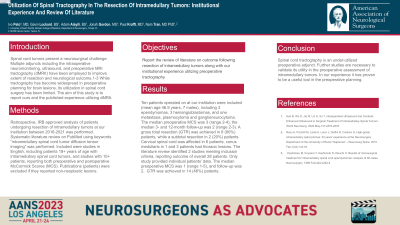Utilization Of Spinal Tractography In The Resection Of Intramedullary Tumors: Institutional Experience And Review Of Literature
Utilization of Spinal Tractography in the Resection of Intramedullary Tumors: Institutional Experience and Review of Literature
Friday, April 21, 2023


Ivo Peto, MD
Resident
University of South Florida
Tampa, Florida, United States
ePoster Presenter(s)
Introduction: Spinal cord tumors present a neurosurgical challenge. Multiple adjuncts including the intraoperative neuromonitoring, ultrasound, and preoperative MRI tractography (dMRIt) have been employed to improve extent of resection and neurological outcome. While tractography has become widespread in preoperative planning for brain lesions, its utilization in spinal cord surgery has been limited. The aim of this study is to report ours and the published experience utilizing dMRIt.
Methods: Retrospective, IRB approved analysis of patients undergoing resection of intramedullary tumors at our institution between 2016-2021 was performed. Systematic literature review on PubMed using keywords “intramedullary spinal cord tumor diffusion tensor imaging” was performed. Included were studies in English, including patients 18+ years of age with intramedullary spinal cord tumors, and studies with 10+ patients, reporting both preoperative and postoperative McCormick Scores (MCS). Publications (patients) were excluded if they reported non-neoplastic lesions.
Results: Ten patients operated on at our institution were included (mean age 46.9 years, 7 males), including 3 ependymomas, 3 hemangioblastomas, and one metastasis, plasmocytoma and ganglioneurocytoma. The median preoperative MCS was 3 (range 2-4), the median 3- and 12-month follow-up was 2 (range 2-3). A gross total resection (GTR) was achieved in 8 (80%) patients, while a subtotal resection in 2 (20%) patients. Cervical spinal cord was affected in 6 patients, conus medullaris in 1 and 3 patients had thoracic lesions. The literature review identified 2 studies meeting inclusion criteria, reporting outcome of overall 28 patients. Only study provided individual patients’ data. The median preoperative MCS was 1 (range 1-5), and follow-up was 2. GTR was achieved in 14 (46%) patients.
Conclusion : Spinal cord tractography is an under-utilized preoperative adjunct. Further studies are necessary to validate its utility in the preoperative assessment of intramedullary tumors. In our experience it has proven to be a useful tool in the preoperative planning.
Methods: Retrospective, IRB approved analysis of patients undergoing resection of intramedullary tumors at our institution between 2016-2021 was performed. Systematic literature review on PubMed using keywords “intramedullary spinal cord tumor diffusion tensor imaging” was performed. Included were studies in English, including patients 18+ years of age with intramedullary spinal cord tumors, and studies with 10+ patients, reporting both preoperative and postoperative McCormick Scores (MCS). Publications (patients) were excluded if they reported non-neoplastic lesions.
Results: Ten patients operated on at our institution were included (mean age 46.9 years, 7 males), including 3 ependymomas, 3 hemangioblastomas, and one metastasis, plasmocytoma and ganglioneurocytoma. The median preoperative MCS was 3 (range 2-4), the median 3- and 12-month follow-up was 2 (range 2-3). A gross total resection (GTR) was achieved in 8 (80%) patients, while a subtotal resection in 2 (20%) patients. Cervical spinal cord was affected in 6 patients, conus medullaris in 1 and 3 patients had thoracic lesions. The literature review identified 2 studies meeting inclusion criteria, reporting outcome of overall 28 patients. Only study provided individual patients’ data. The median preoperative MCS was 1 (range 1-5), and follow-up was 2. GTR was achieved in 14 (46%) patients.
Conclusion : Spinal cord tractography is an under-utilized preoperative adjunct. Further studies are necessary to validate its utility in the preoperative assessment of intramedullary tumors. In our experience it has proven to be a useful tool in the preoperative planning.
